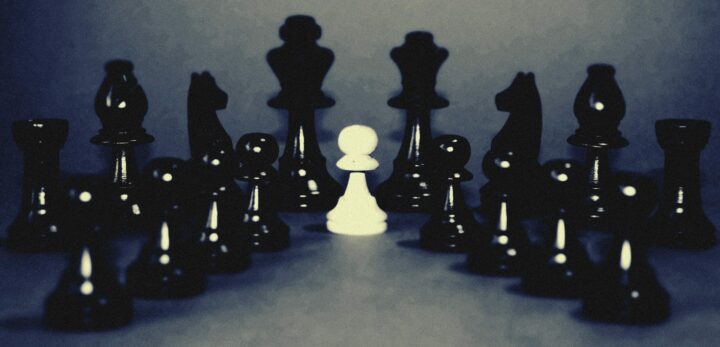Discover the secrets to fortifying your valuable chess pieces and achieving dominance on the board. In this captivating exploration, we delve into the strategies and techniques that will empower you to protect your pieces with precision and finesse.
From the humble pawn to the mighty queen, learn how to shield your army and thwart your opponent’s advances. Get ready to elevate your game and establish an impenetrable defense!
What are the key principles of piece protection in chess?
When it comes to protecting your pieces in chess, understanding the key principles is essential. First and foremost, maintaining a strong central presence can safeguard your pieces by providing a solid foundation.
Secondly, keeping your pieces connected and supporting one another strengthens their defense against potential threats. Additionally, anticipating and identifying your opponent’s plans allows you to proactively defend your pieces.
Lastly, knowing when to retreat or reposition your pieces strategically ensures their safety and longevity on the board. By adhering to these fundamental principles, you establish a formidable defense and create a resilient fortress for your army.
How can proper positioning enhance the safety of your pieces?
Proper positioning of your pieces is a powerful tool in ensuring their safety. Placing your pieces on squares that offer protection and minimize vulnerability is crucial.
Centralizing your pieces allows for greater mobility and control over the board while maintaining a harmonious balance between offense and defense.
Additionally, utilizing the inherent strengths of each piece, such as knights’ ability to control tricky outpost squares, enhances their safety. By thoughtfully positioning your pieces, you create a formidable defense that frustrates your opponent’s attempts to exploit weaknesses.
Are there specific strategies for safeguarding vulnerable pawns?

Vulnerable pawns require careful attention and strategic planning to ensure their protection. One effective strategy is establishing a pawn structure that provides mutual support, forming a solid defensive wall.
Additionally, advancing pawns cautiously and considering potential weaknesses or exposed squares is crucial. Shielding vulnerable pawns with well-placed pieces, such as knights or bishops, can fortify their defense.
Moreover, anticipating and countering opponent’s attempts to target weak pawns strengthens their protection. By implementing these strategies, you safeguard your pawns and maintain a solid foundation for your game.
Which pieces require extra attention and protection in the early game?
In the early game, certain pieces demand extra attention and protection to establish a strong position. The king, as the most valuable piece, should be safeguarded through timely castle and proper positioning.
Pawns, which form the backbone of your defense, require vigilance as their capture can disrupt your pawn structure. Knights, with their unique jumping ability, should be developed cautiously to avoid unnecessary risks.
Finally, the queen, possessing immense power, requires careful maneuvering to prevent it from becoming a target. By giving these pieces the extra care they deserve, you set the stage for a solid foundation in the game’s opening phase.
What defensive tactics can you employ to counter aggressive opponents?
When faced with aggressive opponents, employing effective defensive tactics becomes imperative. Creating solid pawn structures that restrict your opponent’s attacking opportunities can act as a defensive barrier.
Utilizing tactical maneuvers such as pinning or blocking can neutralize aggressive pieces. Moreover, counterattacking strategically, aiming to divert your opponent’s attention from your vulnerable pieces, can disrupt their plans.
Careful calculation and resourceful defensive moves, like interposing or sacrificing, can also thwart aggressive assaults. By staying composed and implementing these defensive tactics, you can weather the storm and turn the tables on your opponent.
Is it advisable to trade pieces to protect your remaining forces?

The decision to trade pieces in order to protect your remaining forces should be approached with careful consideration. In certain situations, trading pieces can alleviate pressure, simplify the position, and reduce the opponent’s attacking potential.
However, it’s important to assess the consequences and long-term implications of each trade. Evaluating the value and importance of the pieces involved, the resulting pawn structure, and potential tactical opportunities is crucial.
Sometimes, retaining certain pieces with defensive capabilities can offer better protection for your remaining forces. Therefore, the decision to trade pieces should be based on a thoughtful analysis of the overall position and the potential benefits or drawbacks.
How can pawn structures contribute to the security of your entire army?
Pawn structures play a significant role in determining the security of your entire army. A well-structured pawn formation can create a protective shield for your pieces, limiting the opponent’s intrusion and attacks.
Maintaining a solid pawn chain or pawn triangle provides stability and denies the opponent’s piece infiltration. Leveraging pawn breaks strategically can open up lines for your pieces while posing challenges to the opponent’s coordination.
Furthermore, using advanced pawns as an offensive and defensive asset can restrict the opponent’s piece mobility and create strategic advantages. By understanding and capitalizing on the influence of pawn structures, you fortify the security of your entire army and lay the groundwork for success on the chessboard.
Are there ways to anticipate and neutralize potential threats to your pieces?
Anticipating and neutralizing potential threats to your pieces is a crucial skill in chess. By carefully analyzing the opponent’s moves and considering their intentions, you can identify potential threats before they materialize.
Being aware of tactical patterns and common attacking motifs allows you to anticipate potential dangers to your pieces.
To neutralize threats, proactive measures like creating counter-threats, reinforcing vulnerable pieces, or blocking opponent’s attacking lines can be employed. By sharpening your tactical vision and staying one step ahead, you can effectively anticipate and neutralize potential threats, ensuring the safety of your valuable pieces.
Which opening variations provide a solid foundation for piece protection?
Certain opening variations provide a solid foundation for piece protection right from the start. Openings that prioritize pawn structure and piece development, such as the Ruy Lopez or the Queen’s Gambit, establish a harmonious balance between offense and defense.
These openings aim to build a strong central presence, allowing your pieces to coordinate and defend one another.
Additionally, openings with solid pawn chains, like the French Defense or the Caro-Kann Defense, provide a sturdy shield for your pieces. By choosing these opening variations, you lay the groundwork for a solid foundation that bolsters the protection of your pieces throughout the game.
Can piece coordination and teamwork enhance their overall defense?
Absolutely! Piece coordination and teamwork are vital in enhancing the overall defense of your army. When your pieces work together harmoniously, their combined strength and support can create a formidable defense.
Coordination can be achieved through tactics like double attacks, discovered attacks, or piece sacrifices to expose opponent weaknesses. Strategic placement and cooperation between different pieces, such as knights and bishops covering critical squares, can fortify their defense. By fostering piece coordination and teamwork, you establish a cohesive defensive unit that effectively safeguards your pieces and maintains a resilient position on the chessboard.
What role does prophylactic thinking play in protecting your pieces?
Prophylactic thinking, also known as preventive thinking, plays a crucial role in protecting your pieces. It involves anticipating your opponent’s plans and taking proactive measures to thwart their ideas before they materialize.
Prophylactic moves aim to eliminate potential threats and create a more secure position for your pieces. This strategic approach involves actions like reinforcing vulnerable squares, limiting opponent’s piece mobility, or neutralizing potential tactics through accurate calculation.
By adopting a prophylactic mindset, you not only protect your pieces but also gain a strategic edge by restricting your opponent’s options and maintaining control over the game.
Are there common mistakes to avoid when it comes to piece defense?

When it comes to piece defense, there are several common mistakes that players should avoid. Neglecting the safety of your pieces or underestimating potential threats can leave them vulnerable to capture or exploitation.
Overextending your pieces, where they become isolated or unsupported, can invite attacks. Failing to assess the opponent’s plans or ignoring the importance of piece coordination can lead to unfavorable positions.
Additionally, overlooking tactical possibilities or making careless moves can jeopardize the security of your pieces. By being aware of these common mistakes and exercising caution and vigilance, you can strengthen your piece of defense and avoid unnecessary setbacks.
How can you capitalize on opponent’s mistakes and strengthen your position?
Capitalizing on your opponent’s mistakes is a critical aspect of strengthening your position and protecting your pieces. When your opponent makes a blunder or commits a tactical oversight, seizing the opportunity is paramount.
By accurately identifying their mistake, you can formulate a plan to exploit it. This may involve launching a counterattack, targeting their weakened pieces, or creating threats that force them into a defensive posture.
Additionally, converting tactical advantages into material or positional gains can solidify your position and increase the security of your pieces. By remaining alert and capitalizing on the opponent’s mistakes, you can turn the tide of the game in your favor.
What are the trade-offs between aggressive play and piece preservation?
Aggressive play and piece preservation involve trade-offs that players must carefully consider. Embracing an aggressive approach can put pressure on the opponent, create tactical opportunities, and disrupt their plans.
However, overly aggressive play may leave your pieces exposed and susceptible to counterattacks. On the other hand, prioritizing piece preservation focuses on maintaining a solid defensive structure and minimizing vulnerabilities.
While this approach ensures the safety of your pieces, it may require sacrificing some offensive potential. Striking a balance between aggression and piece preservation is crucial. Knowing when to push the boundaries and when to consolidate your position helps you optimize your play and protect your pieces effectively.
Can sacrificing a piece be a strategic move to safeguard others?
| Protection Strategy | Advantages | Considerations |
|---|---|---|
| Proper Positioning | Enhances piece safety and control | Requires foresight and understanding of piece dynamics |
| Coordination and Teamwork | Creates a strong defensive network | Requires piece cooperation and careful planning |
| Pawn Structure Management | Forms a solid defensive barrier | Needs consideration of pawn weaknesses and potential imbalances |
| Anticipating Threats | Allows proactive defense and strategic countermeasures | Requires accurate evaluation and anticipation of opponent’s plans |
| Tactical Sacrifices | Creates unexpected opportunities and tactical advantages | Needs careful calculation and assessment of resulting position |
Yes, sacrificing a piece can indeed be a strategic move to safeguard others and create tactical opportunities. Known as a “sacrifice for compensation,” this daring maneuver involves willingly giving up a piece in exchange for substantial positional or tactical advantages.
By sacrificing a piece, you may disrupt the opponent’s coordination, expose their king to attacks, or open up crucial lines for your remaining forces.
These sacrifices can lead to initiative, superior piece activity, or the opportunity to launch a devastating attack. However, careful calculation and accurate assessment of the resulting position are necessary to ensure that the sacrifice yields sufficient compensation and secures the safety of your other pieces.
Closing statements
In the complex game of chess, protecting your pieces is a fundamental aspect of achieving success. By adhering to key principles, positioning your pieces strategically, and employing effective defensive tactics, you can fortify your army and ward off potential threats.
Anticipating and neutralizing dangers, choosing solid opening variations, and promoting piece coordination enhance the overall defense. Prophylactic thinking helps you stay one step ahead, while avoiding common mistakes preserves the security of your pieces.
Capitalizing on opponent’s mistakes and finding the right balance between aggression and preservation further strengthen your position. So, embrace the challenge, refine your defensive skills, and prepare to rise as a formidable chess player.




